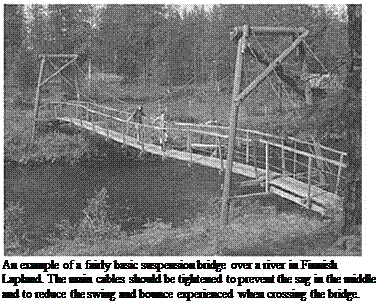These have been used as footbridges for centuries— for example, the rope structures used by the Incas of South America. There are several varieties of suspension bridge, depending on the setting and the amount of use expected.
The simplest and most challenging type consists of four cables slung across the stream. Boards are lashed across the bottom two to form a footway, while the upper pair, loosely lashed to the bottom ones, form a handrail. These bridges are unstable to use, as they tend to swing from side to side. They make an exciting crossing, but they are not recommended for the faint-hearted. However, for low use by experienced hikers in rugged terrain where materials are difficult to transport, such a bridge can be an option.
The usual kind of suspension bridge is a more sophisticated structure. The main cables are secured to the ground at each side of the crossing, and pass over tall uprights anchored into the stream banks. The footway decking is then suspended from these main cables by a series of ‘droppers’ placed at equal intervals. Beams connect the bottom of each pair of droppers and support the decking. A handrail can also be supported by the droppers. The main cables are tensioned to give the decking its characteristic arched shape, while the cables assume a graceful series of
curves.
It is clear that the complexities of design, construction and maintenance of suspension bridges must have an engineer’s input. The size of the cable must be calculated, the anchoring needs to be determined, while the size and strength of the uprights are crucial for safe loadbearing.
 |
Steel cables tensioned by bottle screws will usually be anchored to concrete blocks or ground anchors, depending on the site, the strength of the subsoil, the loading and access for materials. The uprights can be timber frames with special anchor pieces at the top to connect the cables. Smaller steel cables or rods are used for the droppers, and timber can be used for the decking. All the steel should be galvanized, and the timber should be pressure treated with preservative.



